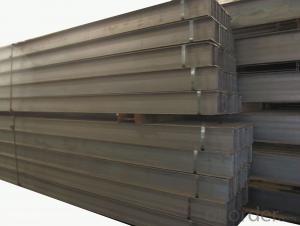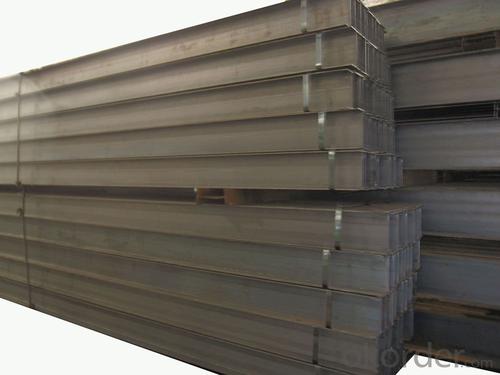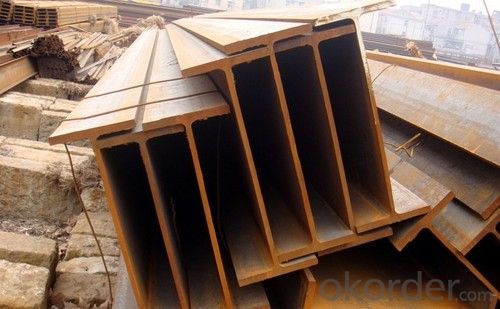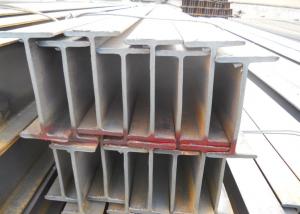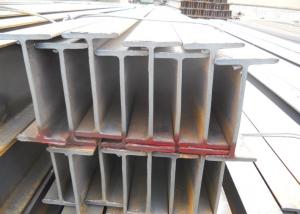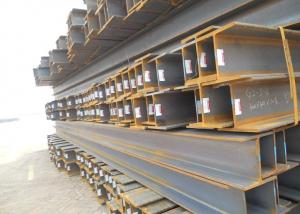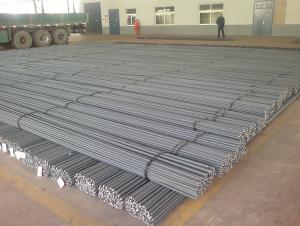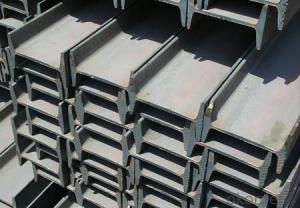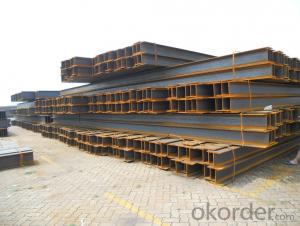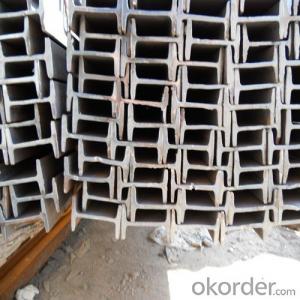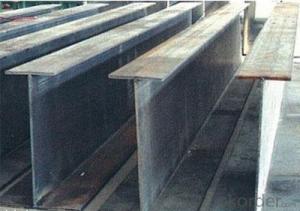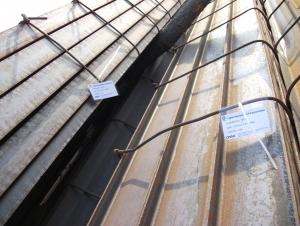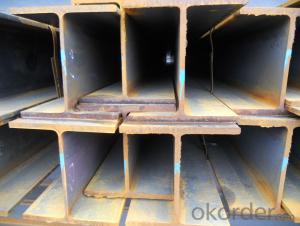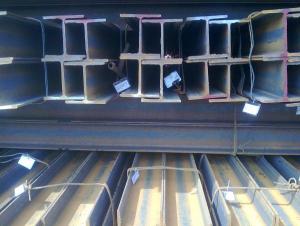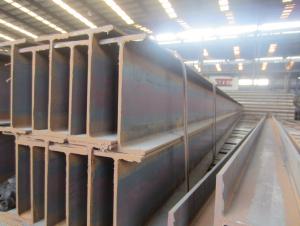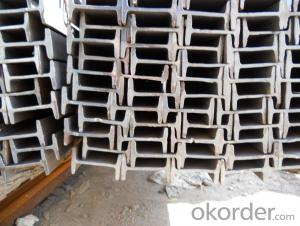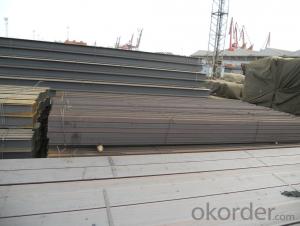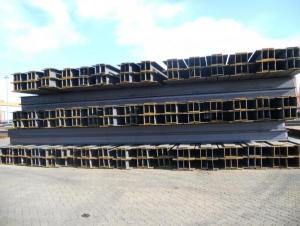Hot rolled steel of h beam for construction
- Loading Port:
- Tianjin
- Payment Terms:
- TT or LC
- Min Order Qty:
- 25 m.t.
- Supply Capability:
- 100000 m.t./month
OKorder Service Pledge
OKorder Financial Service
You Might Also Like
Product Description:
Secifications of Hot Rolled Steel H-beam
1. Standard: JIS 3192
2. Grade: SS400 or Equivalent
3. Length: 10m, 12m as following table
4. Invoicing on theoretical weight or actual weight as customer request
5.Payment: TT or L/C
(1). for the plant, high-rise building construction
(2). for the bridge, shipment building
(3).for lifting and transportation machinery, equipment manufacturing base building
(4). for the support, foundation pile manufacturing
* If you would like to get our price, please inform us the size, standard/material and quantity. Thank you very much for your attention.
Secifications of Hot Rolled Steel H-beam
1. Standard: JIS 3192
2. Grade: SS400 or Equivalent
3. Length: 10m, 12m as following table
4. Invoicing on theoretical weight or actual weight as customer request
5.Payment: TT or L/C
Packaging & Delivery of Hot Rolled H-Beam Steel for Building Structures
1. Packing: it is nude packed in bundles by steel wire rod
2. Bundle weight: not more than 3.5MT for bulk vessel; less than 3 MT for container load
3. Transportation: the goods are delivered by truck from mill to loading port, the maximum quantity can be loaded is around 40MTs by each truc4. If the order quantity cannot reach the full truck loaded, the transportation cost per ton will be little higher than full load.
5. Delivered by container or bulk vessel
Usage of Prime Hot Rolled H Beam Steel :
(1). for the plant, high-rise building construction
(2). for the bridge, shipment building
(3).for lifting and transportation machinery, equipment manufacturing base building
(4). for the support, foundation pile manufacturing
* If you would like to get our price, please inform us the size, standard/material and quantity. Thank you very much for your attention.
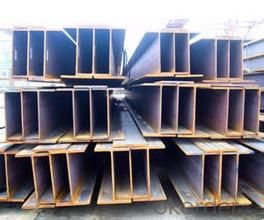

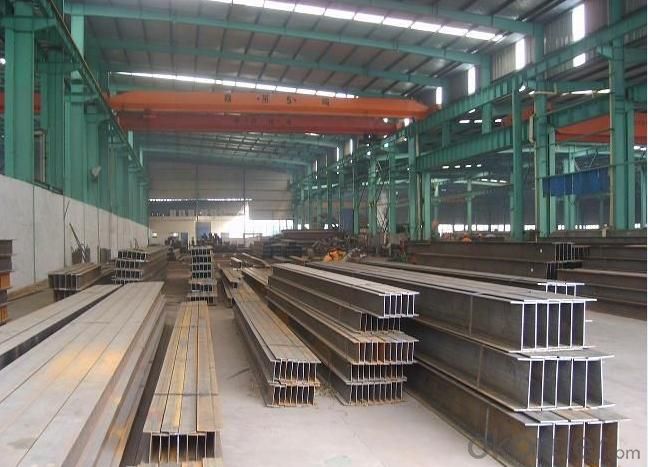
- Q: What are the design considerations for steel H-beams?
- To ensure the structural integrity and optimal performance of steel H-beams, several important design considerations must be taken into account. First and foremost, the load-bearing capacity of the H-beams is crucial. The design needs to consider the anticipated static and dynamic loads that the beams will bear, including the weight of the structure, additional live loads, and potential impacts or vibrations. It is essential to consider the material properties of the steel, such as its yield strength and elasticity, to ensure that the H-beams can withstand the applied loads without excessive deflection or failure. Secondly, the overall geometry and dimensions of the H-beams should be carefully designed. The height, width, and thickness of the flanges and web need to be determined based on the structural requirements and anticipated loads. The proportions and symmetry of the cross-sectional shape play a vital role in maintaining stability and preventing buckling. It is also crucial to design the connection details, such as bolted or welded connections, appropriately to ensure proper load transfer and overall stability. Another significant consideration is the selection of the appropriate steel grade for the H-beams. Different grades of steel possess varying mechanical properties, including strength, ductility, and resistance to corrosion. Factors such as environmental conditions, expected service life, and specific requirements for fire resistance or seismic performance should be taken into account when choosing the steel grade. Additionally, the design of steel H-beams should consider the fabrication and installation processes. The ease of manufacturing, transportation, and erection of the beams should be taken into account. It is important to consider any limitations or restrictions imposed by available manufacturing and construction methods, such as maximum length or weight of the beams. Finally, cost-effectiveness should be considered in the design of H-beams. This involves evaluating the trade-offs between material costs, manufacturing complexity, and overall structural performance. The design should strive to achieve the desired structural integrity and performance while minimizing unnecessary material usage and fabrication costs. In conclusion, the design considerations for steel H-beams encompass assessing load-bearing capacity, optimizing geometry and dimensions, selecting the appropriate steel grade, considering fabrication and installation requirements, and achieving cost-effectiveness. By carefully addressing these considerations, the design of steel H-beams can ensure their safe and efficient use in various structural applications.
- Q: How do steel H-beams contribute to the overall sustainability of a structure?
- There are several ways in which the use of steel H-beams enhances the overall sustainability of a structure. To begin with, steel is an incredibly resilient material that can withstand harsh weather conditions, seismic activities, and fire, ensuring the enduring safety of the structure. This durability eliminates the need for frequent repairs or replacements, reducing resource consumption and waste generation. Moreover, steel H-beams possess a lightweight quality, unlike materials such as concrete or wood, thereby decreasing the overall weight of the structure. This lightweight characteristic facilitates more efficient transportation and construction processes, resulting in reduced energy consumption and carbon emissions during construction. Additionally, steel H-beams are highly recyclable, making them an ideal sustainable choice. At the end of a building's life cycle, these beams can be easily dismantled and transformed into new steel products without compromising their inherent properties. By recycling steel, the demand for new materials is diminished, conserving energy and decreasing greenhouse gas emissions associated with the production of fresh steel. Furthermore, steel H-beams offer design flexibility, enabling architects and engineers to create innovative and efficient structures. Their versatility allows for optimal material usage, minimizing waste and maximizing resource utilization. Moreover, this adaptability facilitates future modifications or expansions of the structure without extensive demolition or reconstruction. Lastly, steel H-beams possess a high strength-to-weight ratio, meaning they can support larger loads with less material. This efficiency in material usage reduces the overall environmental impact of the structure, as less steel is required to achieve the same structural integrity. Consequently, the use of steel H-beams in construction contributes to resource conservation and minimizes the carbon footprint of the building. In conclusion, the utilization of steel H-beams in construction enhances the overall sustainability of a structure due to their durability, lightweight nature, recyclability, design flexibility, and efficient material usage. By opting for steel H-beams, we can construct buildings that are not only safe and long-lasting but also environmentally friendly, conserving resources and reducing the carbon footprint of the construction industry.
- Q: How do you calculate the maximum bending stress in steel H-beams?
- To calculate the maximum bending stress in steel H-beams, you need to determine the moment of inertia of the cross-section and the applied bending moment. The bending stress can then be calculated using the formula: stress = (bending moment * distance from neutral axis) / (moment of inertia * section modulus).
- Q: What are the typical weight and mass of steel H-beams?
- The typical weight and mass of steel H-beams can vary depending on their size and specifications. However, as a general guideline, a standard H-beam with a length of 20 feet can weigh around 200 to 300 pounds per foot, with a total mass ranging from approximately 4,000 to 6,000 pounds.
- Q: Can steel H-beams be used for shopping malls?
- Yes, steel H-beams can be used for shopping malls. Steel H-beams are commonly used in construction due to their high strength and durability. They are capable of supporting heavy loads, making them suitable for large structures like shopping malls. Additionally, steel H-beams provide flexibility in design, allowing for open and spacious layouts commonly found in shopping malls. Their fire resistance properties also make them a safe choice for such commercial buildings. Overall, steel H-beams are a popular choice for constructing shopping malls due to their strength, durability, and design versatility.
- Q: Can steel H-beams be used for supporting communication towers?
- Certainly, communication towers can indeed be supported by steel H-beams. Construction projects often rely on steel H-beams due to their impressive strength and ability to bear heavy loads. These beams offer exceptional structural support and can endure substantial forces, making them an ideal choice for supporting communication towers. The H-shaped design of these beams ensures a larger surface area, enhancing stability and reducing the likelihood of collapse. What's more, steel H-beams boast a lengthy lifespan and demand minimal maintenance, making them both cost-effective and dependable for supporting communication towers.
- Q: What is the standard length of steel H-beams?
- The specific requirements and use cases determine the potential variation in the standard length of steel H-beams. Typically, steel H-beams have a standard length ranging from 40 to 50 feet. This length is widely utilized in construction projects, specifically for framing buildings and other structures. It is crucial to acknowledge that steel H-beams can be tailored and trimmed to fit the precise lengths required for a particular project.
- Q: How are steel H-beams manufactured?
- Steel H-beams are manufactured through a process known as hot rolling. This involves heating a large billet of steel to a high temperature and then passing it through a series of rollers to shape it into the desired H-beam profile. The first step in the manufacturing process is the preparation of the raw materials. High-quality steel is selected, usually in the form of a large billet, which is a semi-finished long product. The billet is then heated in a furnace to a temperature above its recrystallization point, typically around 1200 to 1300 degrees Celsius. Once the billet reaches the desired temperature, it is fed into a rolling mill. The mill consists of a series of rollers that gradually shape the heated billet into the H-beam profile. The rollers apply pressure to the billet, causing it to elongate and take on the desired shape. This process is known as hot rolling because the steel is rolled while it is still hot and malleable. During the rolling process, the billet is continuously passed through the rollers, undergoing multiple passes until it achieves the required dimensions and shape. The shape of the rollers determines the final profile of the H-beam, with each roller gradually shaping the steel into the desired form. After the rolling process is completed, the newly formed H-beams are cooled either by air or water. This cooling process is essential for the steel to retain its strength and structural integrity. Once cooled, the H-beams are cut to the desired lengths and undergo any necessary further processing, such as surface treatment or galvanization, before being packaged and shipped to customers. Overall, the manufacturing of steel H-beams involves the heating of a billet to a high temperature, hot rolling it through a series of rollers to shape it into the desired profile, and then cooling and further processing the finished beams. This process ensures the production of high-quality and structurally sound H-beams that are widely used in various construction and engineering applications.
- Q: Can Steel H-Beams be used in bridge or infrastructure construction?
- Yes, steel H-beams can be used in bridge or infrastructure construction. They are commonly used as structural elements due to their high strength, durability, and versatility. Steel H-beams are capable of withstanding heavy loads and provide excellent support for bridges, buildings, and other infrastructure projects.
- Q: How large H steel are used for steel roof with span of 19 meters and 26 meters respectively?
- The steel roof truss of 26 meters span adopts Q345 steel, the column section adopts H500 * 250 * 10 * 14, and the beam adopts H (800-500) * 220 * 12 * 14
Send your message to us
Hot rolled steel of h beam for construction
- Loading Port:
- Tianjin
- Payment Terms:
- TT or LC
- Min Order Qty:
- 25 m.t.
- Supply Capability:
- 100000 m.t./month
OKorder Service Pledge
OKorder Financial Service
Similar products
Hot products
Hot Searches
Related keywords
